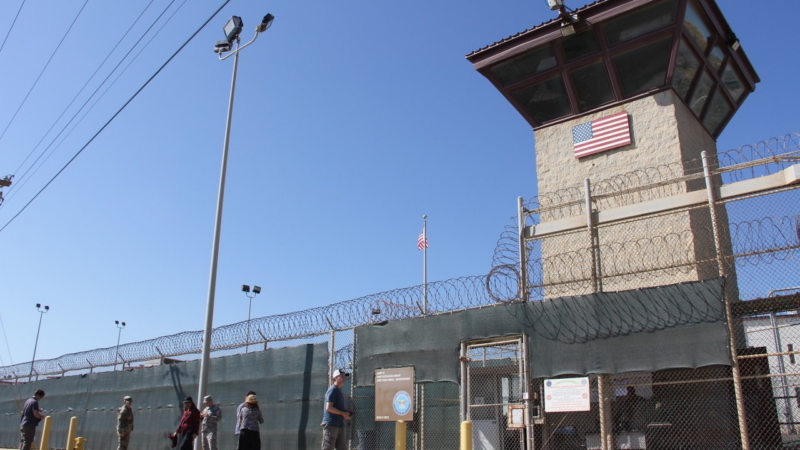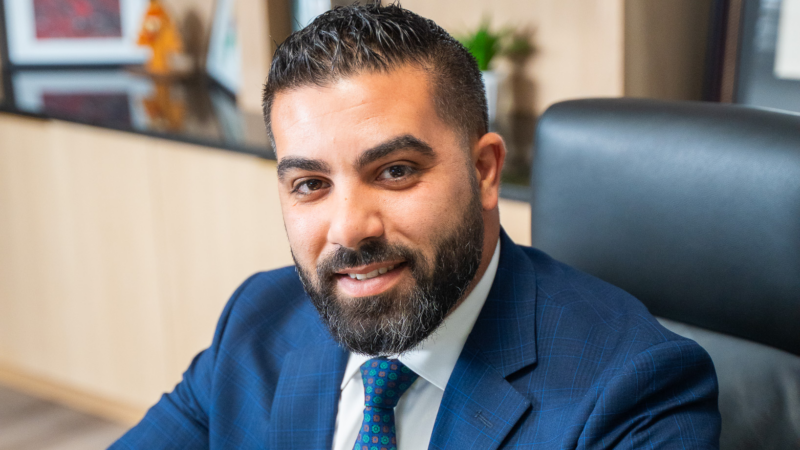U.S. transfers 11 Yemeni prisoners from Guantánamo to Oman
In the most dramatic step in years to reduce the population at the U.S. military prison in Guantánamo Bay, Cuba, the Biden administration has transferred 11 Yemeni detainees to Oman, which has agreed to help resettle them and provide security monitoring.
All of the men, who were captured in the aftermath of the September 11, 2001, terror attacks, had been held for more than two decades without being charged or put on trial. All of them were approved for transfer by national security officials more than two years ago and sometimes long before that — one had been cleared for transfer since 2010 — yet had remained behind bars due to political and diplomatic factors.
Their release leaves just 15 prisoners at Guantánamo, cutting the number of inmates nearly in half.
Monday’s transfers were originally scheduled to happen in October 2023, but were halted at the last minute due to concerns in Congress about instability in the Middle East following the Hamas attack on Israel.
That the plan was resurrected during President Biden’s final two weeks in office signals a last-ditch effort by his administration to shrink Guantánamo’s prisoner population and get closer to his goal of trying to close the facility. In recent weeks, the U.S. has transferred four other Guantánamo inmates — a Kenyan, a Tunisian and two Malaysians — and is preparing for the transfer of at least one more, an Iraqi.
That flurry of activity is motivated by the assumption that Guantánamo transfers may stop once Donald Trump returns to the White House. Trump previously vowed to keep Guantánamo open and “load it up with some bad dudes,” although he did not send any prisoners there. Despite its late push, the Biden administration is unlikely to be able to close Guantanamo’s prison and court before Trump takes office.
The transfer of the 11 Yemenis was the result of lengthy and complicated diplomatic negotiations. They had remained imprisoned despite being eligible for release because they were legally prohibited from returning to Yemen, a failed state deemed highly unstable. That meant the U.S. faced the complex challenge of finding another country or countries to take them. Oman, a U.S. ally, has accepted at least 30 other Guantánamo prisoners in the past.
According to U.S. Defense Department records, all the Yemeni men are former al-Qaeda members, although many of them dispute the U.S. accounts of their backgrounds. Before arriving at Guantánamo between 2002 and 2004, several were held at secret overseas CIA prisons known as black sites, where torture was common.
Eventually, the U.S. government determined they no longer posed a significant enough threat to justify their continued imprisonment. However, several of the transfers are contingent upon “robust” security assurances from Oman, such as monitoring, travel restrictions and “integration support.” Oman has said it will help the men find housing, jobs and other support systems aimed at letting them rebuild their lives, and in some cases will reunite them with family members.
Three other Guantánamo inmates — a Libyan, a Somalian and a stateless Rohingya — have been approved for transfer but remain imprisoned. The Libyan and Somalian cannot be returned to their homelands because those countries, like Yemen, are on Congress’s no-transfer list due to security concerns, so the U.S. must find other countries in which to resettle them.
The Iraqi prisoner whose transfer is in the works has pleaded guilty to war crimes charges and the U.S. wants to send him to a prison in Iraq. However, the man recently filed a federal lawsuit seeking to stop his transfer because he says the Iraqi prison could subject him to abuse and inadequate medical care; he has a disabling spine condition.
The U.S. prison and military court at Guantánamo were set up to house and prosecute suspected foreign terrorists after the 9/11 attacks. The first prisoners arrived in January 2002 and about 780 detainees eventually passed through the facility, most of them never charged yet held for years. Guantánamo’s supporters say it is a security necessity. Critics call it a moral stain on America.
In addition to quelling human rights complaints, transferring prisoners to other countries represents a huge financial savings to the U.S., which spends more than a half-billion dollars a year on Guantánamo’s court and prison. Each inmate held there costs American taxpayers an estimated $15 million a year, compared to about $80,000 annually per inmate at a U.S. supermax facility.
Still, some members of Congress, both Republicans and Democrats, object to releasing Guantánamo prisoners on grounds that they could be a security risk, especially with the ongoing upheaval in the Middle East.
A State Department official told NPR that Monday’s transfer “was the culmination of years of diplomatic effort and it did advance the Biden-Harris administration’s goal of responsibly reducing the detainee population” at Guantánamo.
The 15 remaining prisoners are:
- seven men facing charges, including alleged 9/11 mastermind Khalid Sheikh Mohammed, who has agreed to a plea deal
- three uncharged men not approved for transfer
- three uncharged men approved for transfer but waiting for the U.S. to find countries to take them
- two men who have been convicted
The 11 Yemeni men transferred Monday are:
1. Khaled Ahmed Qassim
captured: December 2001
arrived at Guantánamo: May 2002
cleared for release: July 2022
2. Uthman Abdul al-Rahim Muhammed Uthman
captured: December 2001
arrived at Guantánamo: January 2002
cleared for release: May 2021
3. Moath Hamza Ahmed al-Alwi
captured: December 2001
arrived at Guantánamo: January 2002
cleared for release: December 2021
4. Zuhail Abdo Anam Said al-Sharabi
captured: February 2002
arrived at Guantánamo: May 2002
cleared for release: November 2021
5. Hani Saleh Rashid Abdullah
captured: September 2002
arrived at Guantánamo: October 2002
cleared for release: October 2020
6. Omar Mohammed Ali al-Rammah (alternative name: Zakaria Al-Baidany)
captured: April 2002
arrived at Guantánamo: May 2003
cleared for release: December 2021
7. Tawfiq Nasir Ahmed al-Bihani
captured: late 2001 or early 2002
arrived at Guantánamo: February 2003
cleared for release: 2010
8. Sanad Yislam al-Kazimi
captured: January 2003
arrived at Guantánamo: September 2004
cleared for release: October 2021
9. Hassan Mohammed Ali Bin Attash
captured: September 2002
arrived at Guantánamo: September 2004
cleared for release: April 2022
10. Abdu Ali al-Hajj Sharqawi
captured: February 2002
arrived at Guantánamo: September 2004
cleared for release: June 2021
11. Abdulsalam al-Hela (alternative name: Abd al-Salam al-Hilah)
captured: September 2002
arrived at Guantánamo: September 2004
cleared for release: June 2021
Jury awards $1.68 billion to women who accused director Toback of sexual abuse
Toback, who wrote Bugsy, faces one of the largest #MeToo verdicts in history after a New York jury ordered him to pay 1.68 billion in damages to 40 women.
Judge finds Newsmax aired false and defamatory claims about voting-tech company
A Delaware judge finds the right-wing network aired false and defamatory statements about Dominion Voting Systems' role in the 2020 presidential election. A jury trial is slated for late April.
10 emerging writers win Whiting Awards
The awards, which come with a $50K purse, have helped launch the writing careers of many now well-known authors, including Colson Whitehead, Ocean Vuong, Alice McDermott and Jia Tolentino.
Alabama approves regulations on pharmacy benefit managers in order to help small pharmacies
The Alabama House backed the proposal that will require pharmacy benefit managers to reimburse independent pharmacists at least at the state Medicaid rate for prescription drugs. The bill now goes to Alabama Gov. Kay Ivey.
20 musicians who should get to go to space before Katy Perry
On April 14, Blue Origin plans to launch a space flight with a crew that includes the singer behind the 2010 hit "Firework." But we can think of many other artists who deserve to be among the stars.
Attorney representing a student protester detained by federal immigration agents
Amir Makled sat down with All Things Considered host Juana Summers to describe his experience and what it could mean for other attorneys who are going against the wishes of the Trump administration.









